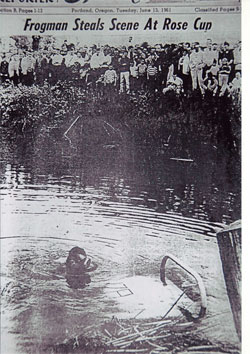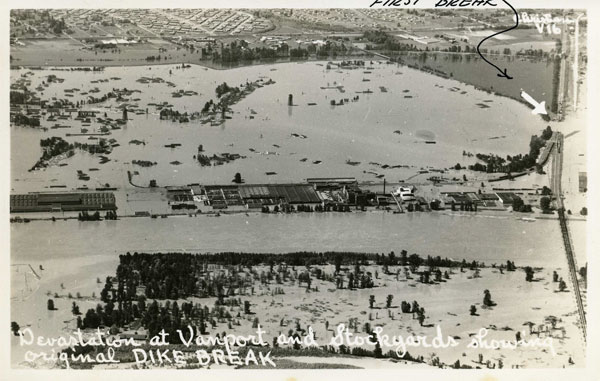Race for the Roses – A Motorsports History Lesson
Portland International Raceway Rose Cup
 Half a century ago in the spring of 1961, something amazing happened in Portland, Oregon that changed the course of the city’s history as a racing and automotive town. And it takes a little history lesson to really get what happened. When World War II came to America in December of 1941, the country suddenly needed a lot more ships than they had been producing. Portland was identified as a good safe place to build ships – it was 60 miles from the coast, and yet had good access to the Columbia River. So in just 6 months, Henry J. Kaiser built a city on a bunch of swampy floodplain at the north end of town. That new city, called Vanport (a mashup of Vancouver and Portland) produced ships all the way through the war, and provided both employment and housing to its workers.
Half a century ago in the spring of 1961, something amazing happened in Portland, Oregon that changed the course of the city’s history as a racing and automotive town. And it takes a little history lesson to really get what happened. When World War II came to America in December of 1941, the country suddenly needed a lot more ships than they had been producing. Portland was identified as a good safe place to build ships – it was 60 miles from the coast, and yet had good access to the Columbia River. So in just 6 months, Henry J. Kaiser built a city on a bunch of swampy floodplain at the north end of town. That new city, called Vanport (a mashup of Vancouver and Portland) produced ships all the way through the war, and provided both employment and housing to its workers.
When the war ended, the shipyards shut down and the workers dispersed into Portland – the housing at the yards was not built to last and started falling apart into a slum. Then in 1948, Mother Nature did some urban renewal when the Columbia River flooded and broke the dikes that protected Vanport. It was like New Orleans after Katrina, and the town was literally washed off the map. When the waters receded, only the city streets were left.
Well, take a depopulated area of town and a bunch of empty streets in the 1950s and what do you think happened? Of course – it was a great underground racing venue. But the police and city fathers started to get concerned about that sort of thing, and there was talk about destroying the old asphalt.
 That’s when the newly-formed Cascade Sports Car Club got together with the Portland Rose Festival and organized a mid-June sports car race on the old roads. On the souvenir program for that event, some optimistic soul wrote “First Annual Rose Cup.”
That’s when the newly-formed Cascade Sports Car Club got together with the Portland Rose Festival and organized a mid-June sports car race on the old roads. On the souvenir program for that event, some optimistic soul wrote “First Annual Rose Cup.”
It’s an act of hope and faith to write “First Annual” on an event that hasn’t even happened yet, but the faith of those early organizers has been rewarded. This year, the 51st Annual Rose Cup races were held in the same place, on the same weekend in June. The Rose Cup is now a Portland tradition, held dear by the local racing community.
 Marshall Atherton was among the men who entered that first Rose Cup race. “I drove an MGA. “I bought the car from a wrecking yard in Eugene. It had been a race car before I bought it. Of course, the cars weren’t so technical like they are today. It was a lot of fun, but it was more like a group of friends.” he says.
Marshall Atherton was among the men who entered that first Rose Cup race. “I drove an MGA. “I bought the car from a wrecking yard in Eugene. It had been a race car before I bought it. Of course, the cars weren’t so technical like they are today. It was a lot of fun, but it was more like a group of friends.” he says.
 Vanport’s position in a swamp was a critical factor to early racers in the Rose Cup. “One of the things I remember was on the front straight, there was a chicane. It was a wooden bridge, and it had blacktop on it, and the blacktop was breaking up. It was an experience. There were scuba divers out there to rescue anyone who ended up in the water.” Atherton says.
Vanport’s position in a swamp was a critical factor to early racers in the Rose Cup. “One of the things I remember was on the front straight, there was a chicane. It was a wooden bridge, and it had blacktop on it, and the blacktop was breaking up. It was an experience. There were scuba divers out there to rescue anyone who ended up in the water.” Atherton says.
And indeed, those scuba divers got to fish at least one Triumph TR-3 out of the soup – there’s photographic evidence of that.
“They used to have separate race for the women and men. When we started at Delta Park, that went away. There was a young lady that raced a Triumph and she managed to go off in the water, I remember we all got together between sessions, dragged the car down to the Texaco station, replaced all the fluids and cleaned the car, and had her back for the afternoon race!”
The event took hold of the automotive community in Portland – which featured a heavy hot rod contingent as well as the sports car enthusiasts. “There were no stands, so people would drive their cars up to the snow fencing around the track and sit in their cars. People would come to watch in the rain. There were so many people, they had second rows of cars. It was like a drive-in movie. Instead of clapping, they’d honk their horns.” Atherton recalls.
 Another driver who was there at the first Rose Cup finished 8th in this year’s event. Monte Shelton is the grand old man of the Rose Cup now – having won 7 times over the years. This year, the Portland Rose Festival named the trophy after him. Monte was 27 when he entered the 1961 event in an Austin-Healey 100M, and at age 78, he shows no signs of slowing down, running his trademark Porsche 934 turbo alongside drivers decades younger than he.
Another driver who was there at the first Rose Cup finished 8th in this year’s event. Monte Shelton is the grand old man of the Rose Cup now – having won 7 times over the years. This year, the Portland Rose Festival named the trophy after him. Monte was 27 when he entered the 1961 event in an Austin-Healey 100M, and at age 78, he shows no signs of slowing down, running his trademark Porsche 934 turbo alongside drivers decades younger than he.
“Monte, he was kind of the Portland star. Always had the best equipment. I look back at those days, and if I ever give credit to anyone for putting racing on the map in Portland, it was Monte. Monte started with basically nothing but desire to be in the automobile industry, and he built his name through racing. I give him all the credit in the world for being there at the right time and having all that desire that he had. He was a fierce competitor.”
It’s often said that there was a time when sex was safe and racing was risky – and the Rose Cup had its share of risk in the early days. “There were pheasants out there, and I was on the back straight, and I managed to hit a pheasant running across the track, it exploded on the grill and ran the temperature up immediately.” Atherton says.
Atherton ran his most recent Rose Cup in 2007, but it’s far from certain that he won’t run again. This year’s contest was won by Brian Richards in a purpose-built SCCA GT-1 class Camaro. Second place was claimed by Loren Beggs in a custom Porsche Cayman with a 996 turbo engine. Third place went to Cindi Lux in a World-Challenge spec Dodge Viper, making Cindi the first woman in Rose Cup history to earn a podium finish.
 Today, the Rose Cup is the second-oldest amateur road race in the United States – only the June Sprints at Road America in Elkhart Lake, Wisconsin is older. The race helped build those old roads into Portland International Raceway – and you can still see the outline of the old city streets from the air! Since 1961, the track has hosted 25 years of Champ Car racing, IMSA, ALMS, NHRA, NASCAR, and many other events. In addition to the title race, the Rose Cup event now includes autocross, drag racing, and a full hot rod cruise-in. So if you find yourself in the upper-left corner of the country in mid-June, be sure to stop in and check it out.
Today, the Rose Cup is the second-oldest amateur road race in the United States – only the June Sprints at Road America in Elkhart Lake, Wisconsin is older. The race helped build those old roads into Portland International Raceway – and you can still see the outline of the old city streets from the air! Since 1961, the track has hosted 25 years of Champ Car racing, IMSA, ALMS, NHRA, NASCAR, and many other events. In addition to the title race, the Rose Cup event now includes autocross, drag racing, and a full hot rod cruise-in. So if you find yourself in the upper-left corner of the country in mid-June, be sure to stop in and check it out.








